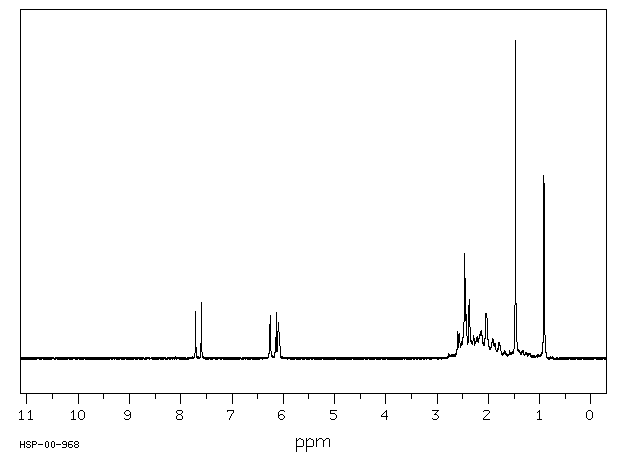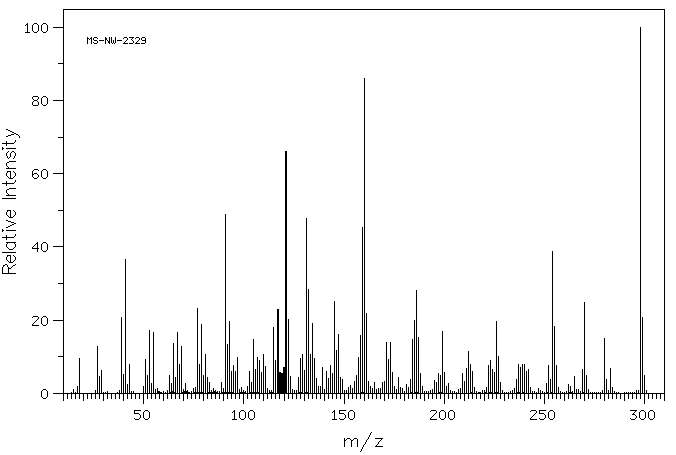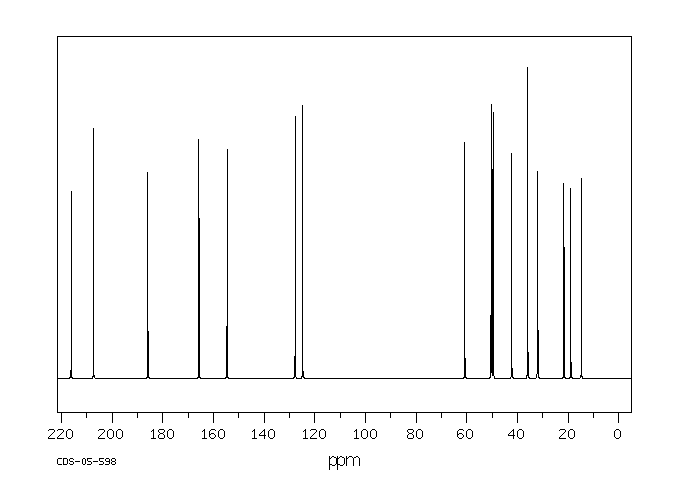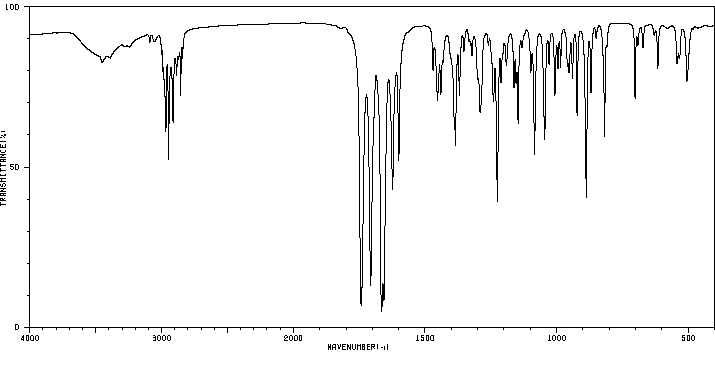1-去氢肾上腺甾酮 | 7738-93-4
分子结构分类
-
物化性质
-
计算性质
-
ADMET
-
安全信息
-
SDS
-
制备方法与用途
-
上下游信息
-
文献信息
-
表征谱图
-
同类化合物
-
相关功能分类
-
相关结构分类
物化性质
-
熔点:193-195 °C
-
沸点:481.5±45.0 °C(Predicted)
-
密度:1.21±0.1 g/cm3(Predicted)
-
溶解度:可溶于丙酮(少量)、氯仿(少量)、乙酸乙酯(少量)
计算性质
-
辛醇/水分配系数(LogP):1.8
-
重原子数:22
-
可旋转键数:0
-
环数:4.0
-
sp3杂化的碳原子比例:0.631
-
拓扑面积:51.2
-
氢给体数:0
-
氢受体数:3
SDS
上下游信息
-
上游原料
中文名称 英文名称 CAS号 化学式 分子量 肾上腺甾酮 adrenosterone 382-45-6 C19H24O3 300.398 1,4-雄二烯-11-beta-醇-3,17-二酮 (8S,9S,10R,11S,13S,14S)-11-Hydroxy-10,13-dimethyl-7,8,9,10,11,12,13,14,15,16-decahydro-6H-cyclopenta[a]phenanthrene-3,17-dione 898-84-0 C19H24O3 300.398 20-二氢强的松 17α,20S,21-trihydroxypregna-1,4-diene-3,11-dione 2899-94-7 C21H28O5 360.45 泼尼松 Prednison 53-03-2 C21H26O5 358.434 泼尼松龙 prednisolon 50-24-8 C21H28O5 360.45 可的松 Cortisone 53-06-5 C21H28O5 360.45 -
下游产品
中文名称 英文名称 CAS号 化学式 分子量 —— 17α-(n-pentylthio)-1,4-androstadiene-3,11-dione 73024-10-9 C24H34O2S 386.599 —— 17β-(methanesulfonyloxy)-1,4-androstadiene-3,11-dione 73038-49-0 C20H26O5S 378.489 —— 17α-(benzylthio)-1,4-androstadiene-3,11-dione 73024-08-5 C26H30O2S 406.589 —— 17α-<(β-phenylethyl)thio>-1,4-androstadiene-3,11-dione 73024-09-6 C27H32O2S 420.616 —— 17,17-(ethylenedioxy)-androst-1,4-diene-3,11-dione 13400-82-3 C21H26O4 342.435 —— 17α-<(2-methylbenzyl)thio>-1,4-androstadiene-3,11-dione 73024-25-6 C27H32O2S 420.616 —— 17α-<(2,4-dichlorobenzyl)thio>-1,4-androstadiene-3,11-dione 73024-13-2 C26H28Cl2O2S 475.479
反应信息
-
作为反应物:描述:1-去氢肾上腺甾酮 在 lithium tri-t-butoxyaluminum hydride 作用下, 以 四氢呋喃 为溶剂, 生成 17β-hydroxy-1,4-androstadiene-3,11-dione参考文献:名称:光化学反应。34. Mitteilung。在Dioxanlösung中死于3-Oxo-Δ1 ; 4 - Steroiden的Photoisomerisierung。3,11-二氧杂17β-乙酰氧基-Δ1 ; 4-雄甾烷和3-氧杂-17β-乙酰氧基-Δ1 ; 4; 9,11-雄甾烷摘要:在二恶烷溶液中对类固醇交叉共轭二烯酮3和7以及双环己烯酮衍生物16进行紫外线照射,产生了几乎定量的异构化3 11(图3)和7 16 17(图6)。这些转换与先前建立的通用方案abcde(图1)一致。通过与这些结果的类比,建议O-乙酰基泼尼松(8)的光异构体9和10代表由多次光重排而不是直接转化产生的产物,如文献中所提出的。DOI:10.1002/hlca.19660490315
-
作为产物:参考文献:名称:皮质抑素 A 和相关结构的可扩展合成摘要:为改进皮质抑素 A 和相关结构的合成以及策略的基本逻辑和演变提供了完整的细节。嵌入关键杂金刚烷的高度功能化的皮质抑素 A 环是通过简单且可扩展的五步序列合成的。未活化甲基的化学选择性串联双卤化、溴环丙烷的还原断裂/捕获/消除和简便的化学选择性醚化反应提供了皮质抑素 A 核心,称为“皮质他汀酮”。用 Raney Ni 选择性还原 Δ(16)-烯烃提供了皮质抑素 A。通过这种可扩展且实用的途径,大量的皮质抑素、Δ(16)-皮质抑素 A(皮质抑素 A 的等效直接前体)及其相关类似物被为进一步的生物学研究做好准备。DOI:10.1021/ja202103e
文献信息
-
一种17-羟基腈甾体衍生物的制备方法
-
Inhibition of <i>Mycobacterium tuberculosis</i> AhpD, an Element of the Peroxiredoxin Defense against Oxidative Stress作者:Aleksey Koshkin、Xiao-ti Zhou、Carl N. Kraus、Jason M. Brenner、Pradipta Bandyopadhyay、Irwin D. Kuntz、Clifton E. Barry、Paul R. Ortiz de MontellanoDOI:10.1128/aac.48.7.2424-2430.2004日期:2004.7
ABSTRACT The resistance of
Mycobacterium tuberculosis to isoniazid (INH) is largely linked to suppression of a catalase-peroxidase enzyme (KatG) that activates INH. In the absence of KatG, antioxidant protection is provided by enhanced expression of the peroxiredoxin AhpC, which is itself reduced by AhpD, a protein with low alkylhydroperoxidase activity of its own. Inhibition of AhpD might therefore impair the antioxidant protection afforded by AhpC and make KatG-negative strains more sensitive to oxidative stress. We report here that the 3(E ),17-dioxime of testosterone is a potent competitive AhpD inhibitor, with aK i of 50 ± 2 nM. The inhibitor is stereospecific, in that the 3(E ) but not 3(Z ) isomer is active. Computational studies provide support for a proposed AhpD substrate binding site. However, the inhibitor does not completely suppress the in vitro activity of AhpC/AhpD, because a low titer of AhpD suffices to maintain AhpC activity. This finding, and the low solubility of the inhibitor, explains its inability to suppress the growth of INH-resistantM. tuberculosis in infected mouse lungs.摘要 结核分枝杆菌 结核分枝杆菌 对异烟肼(INH)的耐药性在很大程度上与激活 INH 的过氧化氢酶(KatG)被抑制有关。在 KatG 缺失的情况下,过氧化氢过氧化物酶 AhpC 的表达增强可提供抗氧化保护,而 AhpC 本身会被 AhpD 还原,后者是一种自身烷基氢过氧化物酶活性较低的蛋白质。因此,抑制 AhpD 可能会损害 AhpC 提供的抗氧化保护,使 KatG 阴性菌株对氧化应激更加敏感。我们在此报告 3( E ),17-睾酮二肟是一种强效的 AhpD 竞争性抑制剂,其 K K i 为 50 ± 2 nM。该抑制剂具有立体特异性,即 3( E ) 而非 3( Z ) 异构体具有活性。计算研究为所提出的 AhpD 底物结合位点提供了支持。然而,抑制剂并不能完全抑制 AhpC/AhpD 的体外活性,因为低滴度的 AhpD 足以维持 AhpC 的活性。这一发现以及抑制剂的低溶解度解释了为什么它不能抑制耐 INH 结核杆菌的生长。 结核杆菌 在受感染小鼠肺部的生长。 -
Novel 17.alpha.-chloro-17.beta.-sulfoxide steroids as specific inhibitors of sebaceous gland activity: potential antiacne agents作者:Michael J. Green、Robert Tiberi、Richard W. Draper、F. Emilie Carlon、Rudolph O. Neri、Ted T. Kung、Andrew T. McPhail、Kay D. OnanDOI:10.1021/jm00355a016日期:1983.1described. They were obtained from the corresponding 17 alpha-sulfides by chlorination and oxidation with iodobenzene dichloride in aqueous pyridine at -40 degrees C. A single-crystal X-ray structure determination of 17 alpha-chloro-17 beta-(benzylsulfinyl)-1,4-androstadiene-3,11-dione (4) established the absolute configuration at sulfur to be R. From an analysis of their CD spectra, some of the other
-
Electrochemically Enabled One‐Pot Multistep Synthesis of C19 Androgen Steroids作者:Florian Sommer、C. Oliver Kappe、David CantilloDOI:10.1002/chem.202100446日期:2021.4are typically required. Herein, we present mild, safe, and sustainable electrochemical strategies for the preparation of C19 steroids. A reagent and catalyst free protocol for the removal of the C17 side chain of corticosteroids via anodic oxidation has been developed, enabling several one‐pot, multistep procedures for the synthesis of androgen steroids. In addition, simultaneous anodic C17 side chain
-
C-1-dehydrogenation of steroids by spores of septomyxa affinis作者:Kartar Singh、S.K. Sehgal、Claude VezinaDOI:10.1016/0039-128x(63)90028-x日期:1963.11C-1-dehydrogenation of steroids by fusaria. Since then, the reaction has been reported with a large number of microorganisms2–5. With fusaria1, Streptomyces lavendulae 2, Cylindrocarpon radicicola 2, Septomyxa affinis 6 and many other microorganisms investigated (using vegetative growth) C-1-dehydrogenation was often accompanied by the oxidative degradation of C-17 side chain, Transformation of steroids with microbial摘要 Vischer 和 Wettstein 1 在 1953 年观察到镰刀菌对类固醇的 C-1-脱氢作用。从那时起,已经报道了大量微生物的反应2-5。对于 fusaria1、Streptomyces lavendulae 2、Cylindrocarpon radicicola 2、Septomyxa affinis 6 和许多其他研究的微生物(使用营养生长),C-1-脱氢通常伴随着 C-17 侧链的氧化降解,类固醇与微生物孢子的转化具有之前已经描述过7,8。在本通讯中,我们描述了由 Septomyxa affinis ATCC 6757 的孢子对孕烷系列的一些类固醇进行 C-1-脱氢,以及类固醇分子中的 17α-烷基取代基对侧链降解的影响。
表征谱图
-
氢谱1HNMR
-
质谱MS
-
碳谱13CNMR
-
红外IR
-
拉曼Raman
-
峰位数据
-
峰位匹配
-
表征信息










